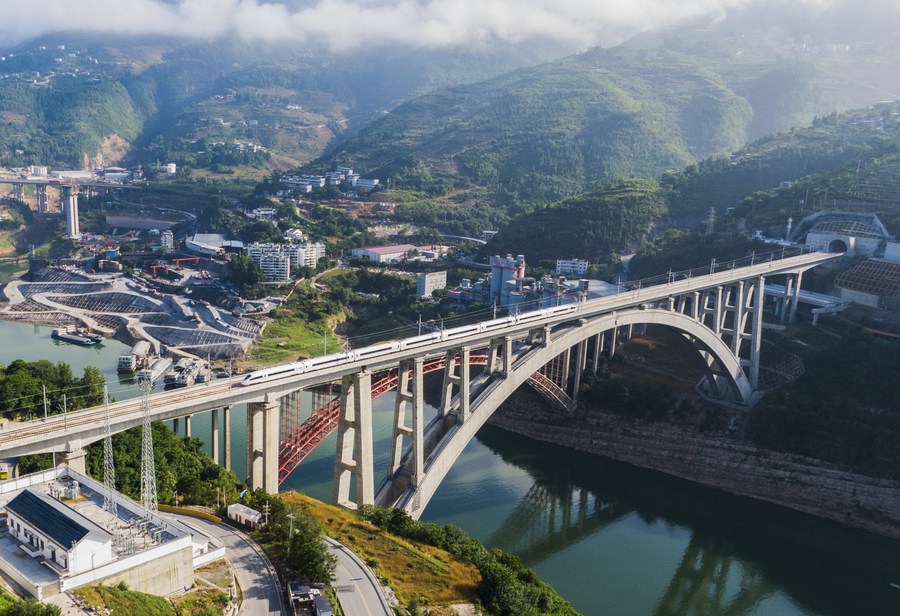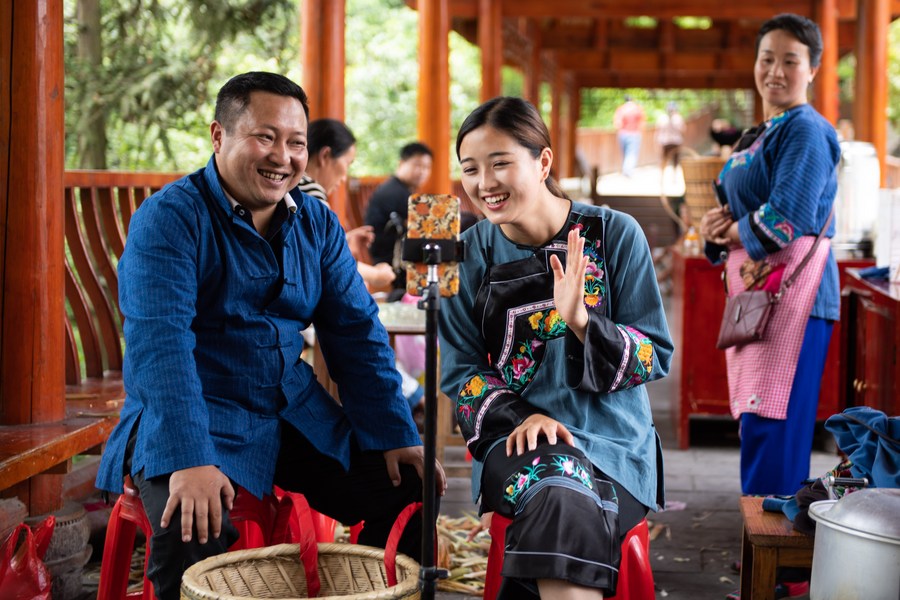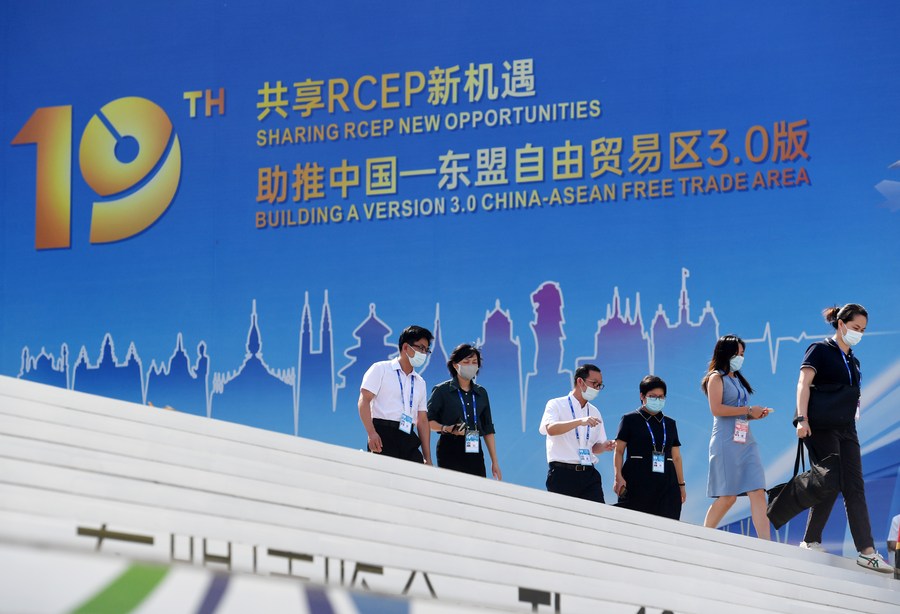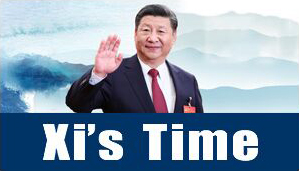
Aerial photo taken on June 20, 2022 shows a train running on the Meixi River grand bridge on the Zhengzhou-Chongqing Highspeed Railway in southwest China's Chongqing. (Photo by Shu Peng/Xinhua)
"China's path to modernization reflects Chinese wisdom, Chinese civilization and history," said Keith Bennett, a long-term China specialist and vice chair of Britain's 48 Group Club.
BEIJING, Dec. 31 (Xinhua) -- China's modernization has changed the global political and economic landscape like never before.
Over the past several decades, China has been modernizing a country home to 1.4 billion people -- or one-fifth of the global population -- to become the world's second-largest economy. Its march toward modernization has global ramifications.
But what makes China's modernization different from some developed countries today? For starters, the country's development isn't capital-centered, polarized and materialistic, featuring external expansion and plundering. Its growth isn't stained by a history of imperialism and colonialism. Instead, China's path is one of peace and development, win-win cooperation and harmony between humanity and nature.
Its chosen development model meets humanity's challenges and offers other countries, especially developing nations, a choice for achieving social and economic progress.

Ma Huihuang (L), then head of the poverty alleviation work team in Shibadong, promotes local products via live-streaming together with villager Shi Linjiao in Shibadong Village of Xiangxi Tujia and Miao Autonomous Prefecture, central China's Hunan Province, May 15, 2020. (Xinhua/Chen Sihan)
PEOPLE-CENTERED PHILOSOPHY
When illustrating Chinese modernization, Chinese President Xi Jinping said that Chinese modernization is the modernization of a huge population, of common prosperity for all, of material and cultural-ethical advancement, of harmony between humanity and nature and of peaceful development.
Xi's remarks signaled the country's commitment to taking the people's aspirations, both at home and abroad, for a better life as modernization's ultimate goal.
In 2021, China announced a "complete victory" in its fight against poverty, which means absolute poverty has been eradicated in the world's most populous country.
Since the launch of the reform and opening-up policy in the late 1970s, 770 million impoverished rural residents have shaken off poverty when calculated in accordance with China's current poverty line. China is responsible for over 70 percent of the world's poverty reduction over the same period, World Bank statistics have shown.
No wonder UN Secretary-General Antonio Guterres called China's achievements in poverty reduction "the biggest contribution for dramatical reduction of poverty," with China's victory having far-reaching significance for the world.
It took China about 70 years, especially the past four decades, to grow from a primarily agricultural country to a global growth powerhouse, a manufacturing hub and a leader in cutting-edge technologies. From 2013 to 2021, China's average contribution to global economic growth exceeded 30 percent, ranking first worldwide.
"I saw extraordinary changes. One is the China of 1994, already with a lot of progress and development, but a very different one is the China of 2022, with great modernity," said Ecuadorian President Guillermo Lasso, who visited China in 1994 and this past February.
"I was very impressed by the (Pudong) financial center, its modern buildings, modern facilities, and practically, a China that has evolved technologically to meet the well-being of the Chinese people," he said, referring to the center in Shanghai.
Today, China is assisting African countries in driving agricultural development to alleviate poverty. At the same time, it has invited scientists from all over the world to board its space station.
Recalling his trip to China in 2020 as "an eye-opener" to see the high living standards of the Chinese people, Kiribati President Taneti Maamau said, "this is a great achievement testifying to the country's people-centered development vision."
For General Secretary of the Congolese Labor Party Pierre Moussa, the Chinese path to modernization serves as an "example" for developing countries, especially African countries.
This "concept through innovation," among other things, would "enlighten many countries in the world," Moussa said.

Participants walk outside the Nanning International Convention and Exhibition Center, the venue of the 19th China-ASEAN Expo and the China-ASEAN Business and Investment Summit, in Nanning, south China's Guangxi Zhuang Autonomous Region, Sept. 16, 2022. (Xinhua/Lu Boan)
WIN-WIN COOPERATION
China has been modernizing itself through peaceful development. It has been championing an open economy and promoting more balanced, inclusive and sustainable growth, thus enabling the world to share in its development opportunities. When the world succeeds, China succeeds.
Jan. 1, 2023, marks the first anniversary of the entry into force of the Regional Comprehensive Economic Partnership (RCEP). Signed by 15 Asia-Pacific members, including China, the pact created the world's largest free trade area.
A milestone in China's opening-up, RCEP has served as a key support for regional trade through a tough year like 2022. From January to August, trade between China and the other 14 RCEP members reached 1.2 trillion U.S. dollars (about 8.32 trillion yuan), or 30.5 percent of China's total foreign trade.
Meanwhile, multiple landmark projects are creating new growth drivers for economies along the Belt and Road. The Jakarta-Bandung High-Speed Railway, connecting Indonesia's capital Jakarta and the city of Bandung, is expected to considerably boost the Southeast Asian country's development once in operation.
"Chinese modernization will undoubtedly provide more opportunities and bring bigger market, more technology and talents," said Low Kian Chuan, president of the Associated Chinese Chambers of Commerce and Industry of Malaysia.
From 1978 to 2021, China's gross domestic product skyrocketed from 53 billion dollars to some 16 trillion dollars. In 2021 alone, China's economic aggregate accounted for 18.5 percent of the world's total.
China is home to the world's largest high-speed railway network and world-class port clusters. Globally, it has been a significant trader in goods and one of the most popular destinations for foreign investment. The country now boasts the world's most extensive social welfare system.
While pursuing high-quality development, China emphasizes sustained development, seeking harmonious coexistence between humanity and nature. The country has cut its carbon emission intensity by 34.4 percent over the past 10 years. It pledged to peak CO2 emissions before 2030 and achieve carbon neutrality before 2060.
Besides the Belt and Road Initiative, China has proposed the Global Development Initiative (GDI) and the Global Security Initiative (GSI), offering its vision of building a human community with a shared future to secure development and peace for generations.
"The GDI and the GSI proposed by China, which invite the participation of all countries in the world, will support the international community's pursuit of peace and development," said Jean Christophe Iseux von Pfetten, president of the Institute for East-West Strategic Studies in Britain.
Noting that China has followed "a pragmatic path" and achieved an industrial and social transformation without colonization, imperialism or exploiting other countries, John Pang, a senior fellow at New York-based Bard College, said the Chinese path to modernization offers the Global South an alternative model to pursue modernization attuned to their own realities.
"China's path to modernization reflects Chinese wisdom, Chinese civilization and history," said Keith Bennett, a long-term China specialist and vice chair of Britain's 48 Group Club.
"The modernization of a small number of Western countries was based on the exploitation, oppression and colonization of almost the entire world. China is not developing by exploiting any other country; China is developing itself and modernizing itself, and at the same time helping other countries to develop and modernize," he said.
"China's drive towards common prosperity will hold valuable lessons not only for developing countries but for developed countries too," Bennett said. ■




